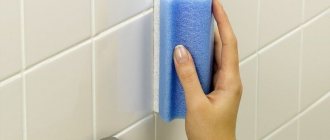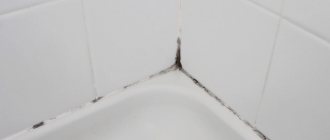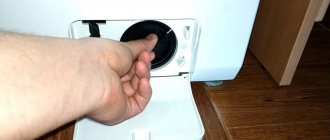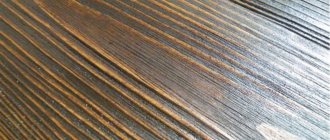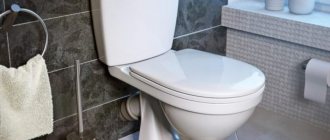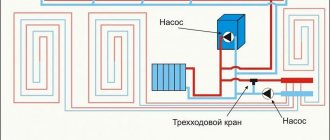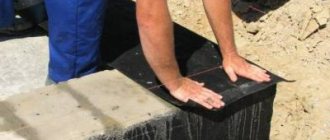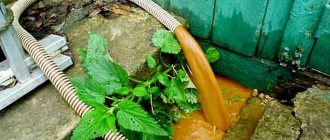A wooden residential building often suffers from various kinds of misfortunes. Harmful underfloor fungus is one of the most common problems plaguing the lives of homeowners. The spread of fungus in the house usually begins in the basement or cellar.
How to remove mold from wood
By attacking wood, mold spoils its aesthetic appearance. But the main danger of the fungus is not damage to property, but its negative impact on the human body. Spores can provoke an allergic reaction and even cause mycotic pathologies. If the damage is minor, you can remove mold from wood yourself, using antiseptics or improvised means.
General recommendations for whitening
So, the main recommendations:
- after bleaching, any composition must be washed off with water;
- acid-based bleach is washed off with an aqueous solution of soda;
- You cannot combine different compositions; the surface can only be treated with one product.
- if the wood is severely affected by fungus, it is necessary to treat it with a more concentrated composition.
- bleaching is most effective if it is carried out at a temperature of 18-20 degrees Celsius and at a humidity of about 60%;
- When processing wood inside the house, it is necessary to ensure ventilation of the room, because Almost all formulations contain components that are unsafe for health. If the treatment was carried out in a bathhouse, it is necessary to dry-heat the room twice before taking bath procedures to remove chlorine fumes.
Below you will learn how to whiten a log house after sanding.
Causes of mold formation on wood
Before looking at how to remove mold from wood, it is important to find out why it appears. The first sign that there is fungus in the house is a change in color. A characteristic brown, blue, black, pink or white color appears on the surface of the wood. At first the spots are barely visible. And in the absence of timely treatment, they increase in size and affect large areas of the material.
Some bacteria do not destroy the texture and do not penetrate deep into the wood. But they can ruin the aesthetic appearance of wood trim, floorboards or wall cladding. There are several reasons why fungus appears on wood:
- improperly organized ventilation in the room;
- high humidity;
- sudden temperature changes;
- condensate;
- low-quality wooden material;
- infection of wood by fungi;
- contact with damp soil for a long time.
Mold fungus is dangerous not only because it multiplies quickly, but also because it has a negative impact on people and pets. If you use material contaminated with mold to build or decorate a house, the consequences can be very serious, including the complete dismantling of wooden structures.
Prevention measures
After the fungus in the cellar has been destroyed, care must be taken to ensure that it does not reappear. Preventive measures will help with this.
- Insulate the building and install waterproofing.
- Make a plan to regularly inspect areas where excess moisture may occur, paying particular attention to corners, joints, and areas where sunlight does not penetrate or occurs very rarely.
- Ventilate the basement and avoid moisture.
- Treat all surfaces, both wood and other materials, with a fungicidal antiseptic.
If you are in the process of building, follow the advice and be careful in advance to prevent fungus from taking up residence in the house.
- A ventilation device will help avoid problems with humidity. If it is impossible to design a supply and exhaust system, at least make windows for ventilation. It’s good if sunlight also penetrates through them.
- Insulate the foundation and waterproof the basement and subfloor.
- Construction materials must be treated with an antiseptic.
- It’s good if the basement has heating.
Step-by-step removal of mold in wooden products
Elimination of consequences and prevention of further proliferation of fungal spores is carried out in several stages. How to remove mold from a wooden surface if the problem is found in a neglected state:
- Cleaning damaged areas. You will need a spatula and a chisel. Remove the top layers with a spatula. A chisel and knife are used if damage to the internal structure of the wood is detected.
- Dispose of all removed wood. It is advisable to burn all cut layers of wood.
- Washing the material. Prepare a concentrated solution of laundry soap and carefully treat cleaned wooden surfaces.
- After treatment with soapy water, the wood is allowed to dry. Then they are treated with a wood antiseptic. After disinfection, the wood is allowed to dry and the treatment of problem areas is repeated.
Important! You need to apply an antiseptic not only to areas damaged by mold, but also to areas around it. There may be spores scattered there that have not yet had time to manifest themselves.
Renewing old darkened wood
In recent years, the trend of not only building new wooden houses, but also restoring houses and already battered buildings has become increasingly popular.
It's no secret that over time, wood loses its pristine beauty: the golden, warm color of this natural material fades and darkens within a few years. And constant exposure to precipitation, temperature changes and other factors lead to the formation of mold and mildew. How to restore old, darkened wood, returning it to its former attractive appearance? There are currently several different ways to solve this problem.
Some people prefer to use radical methods, such as siding or facing a wooden structure with bricks. But such options do not initially imply the preservation of WOOD, so we will not dwell on them in detail. Let's consider only those methods that allow you to restore, renew and refresh damaged wood, and not hide it “out of sight”:
| Recovery methods | Advantages | Flaws | Result |
| 1. Grinding is a mechanical method that allows you to remove existing biological damage and remove the top darkened layer of wood |
|
| The wood will look completely new and fresh, but we must not forget about the need for its MANDATORY further treatment with bioprotective and antiseptic compounds. Otherwise, the result will be very short-lived. |
| 2. Coloring - usually with inexpensive enamels or paints |
|
| A building treated in this way will look refreshed and updated for some time, but, unfortunately, it will no longer look very wooden. And non-breathable coatings that form cheap paints and enamels will lead to the destruction of wood from the inside. |
| 3. Wood bleaching – the most popular currently are chlorine bleaching compounds. |
|
| As in the first case, we will get practically new wood with a fresh and light color. But there is still a lot of work ahead - bioprotective treatment and, if desired, giving the wood the desired color. |
| 4. Use of a restorative composition - for example, Aquatex Restorer |
|
| The result is impressive. After applying just two layers of the composition, we get not just renewed wood, but a durable coating of the desired color, providing bioprotection and strengthening the aged wood. |
There can be no consensus on the best way to renew wood that has darkened over time. Radical measures are necessary only in extreme cases; most often the problem can be solved with minimal effort. When choosing a method that is optimal, remember that we are talking about your home and the comfort in it. Excessive savings are hardly appropriate here. It is worth taking into account all the circumstances and giving preference to the most effective means that will allow you to restore wood efficiently and quickly.
| Old, unpainted house | House coated with Aquatex Restorer |
Of course, all of the listed methods of wood renewal are quite viable and have a right to exist. But now it can be argued that the use of a restoration composition, such as Aquatex Restorer, is exactly the way through which we get the desired result with minimal effort.
How to clean boards from mold
There are two ways to clean boards from mold: call a specialized service that specializes in removing infected areas or get rid of the fungus yourself. If large-scale wood damage is detected, it is better to use the services of specialists. Since such companies determine the type of disputes and select the most effective means of destruction. In addition, processing is carried out with professional equipment.
If you decide to remove the fungus yourself, a person will need to prepare tools for the work and disinfectants that destroy mold spores.
Why is it important to process wood for construction?
Fungi that attack wood can be of two types:
- wood coloring - do not destroy the strength of the tree, but affect the appearance, painting it blue or dark;
- wood-destroying ones are more unsafe, because some independently produce water for development, under their influence the wood becomes porous, rots and disintegrates over time. It can be unrealistic to fight them.
How to check what specific fungus has infected a tree, is it smoldering or just mold that needs to be removed? This can be created using a nail: if, when pressed, it penetrates more than 0.5 centimeters into the body of the tree, the tree rots; if the hand feels resistance, everything is in order and it will be enough to remove the plaque, treat it with bleaching and disinfectants.
Usually builders deal with the newest wood species, on which blue fungus is more often found. Those lumber that are planned to be used for interior decoration of residential premises require close attention. For example, larch lumber, which is popular as a floorboard, is coated with a clear varnish to preserve the visible part of the beautiful structure of the wood. Larch itself is resistant to microbial action. But the blue fungus, “settled” inside, over time destroys the outer coating, provides access to water to the tree, which contributes to its development and infection by other types of microbes.
Scientific fact: destructive bacteria that infect wood are not safe for humans. And their eradication is a concern for the most important thing: people’s health.
Therefore, during construction, it is important not to allow infected wood to be used. To do this, it is enough to remove the fungus using special means and deprive it of its ability to spread. After this, the tree can be used for its intended purpose.
How to get rid of mold on a wooden surface
If the material is only slightly affected, the following will help get rid of mold:
- chisel and spatula;
- sandpaper;
- hammer;
- soft rags and fine sandpaper.
The scale of mechanical intervention depends on the depth of penetration of fungal spores. Sometimes it is enough to remove the thin top layer and then perform disinfection without severe damage to the timber.
Antiseptic
A properly selected chemical solution will destroy mold growth areas. As a rule, universal antiseptics and active fungicides are used for these purposes. The following have proven themselves well in the fight against disputes:
Important! Any chosen anti-mold product is used strictly according to the instructions. In addition to the recommended dosage, it is important to pay attention to the optimal temperatures at which processing is performed.
These antiseptics do not contain dangerous chlorine compounds and volatile toxins. At the same time, they are capable of not only destroying areas of bacterial growth, but also subsequently protecting the wood from spores. In addition, there are solutions that additionally have a toning effect. This allows the lumber to retain its natural appearance.
Folk remedies
Before treating the timber against fungus and mold using professional means, you can try traditional methods of combating it. Such means were successfully used for control even before special chemical solutions appeared on the construction market. Among the most popular are the following:
Advice from professionals
More than once I have come across the view that damage to lumber 1 mm wide does not completely threaten lumber, logs, or beams and therefore we are in no hurry to deal with this problem.
Indeed, wood-staining fungi and mold at the initial stage of development will not be able to cause significant harm to the wood material, they will not increase its strength, and will not destroy the system in the coming months.
But do not forget that they will prepare the wood surface for the emergence of other, already most unsafe wood-destroying fungi, which will quickly begin to destroy the wood.
It will be even more difficult to kill these pests, and the damage caused to the wood material will no longer be removed, it will no longer be possible to restore its former strength, or improve its appearance.
Therefore, the appearance of wood-staining fungi on logs, beams and lumber should be an alarming signal for the owners and they should immediately begin to eliminate them.
In addition, if wood in a residential area is contaminated with them (for example, crowns in a house), then residents, inhaling their spores, cause greater harm to their own health. Allergic diseases may appear (disturbances in normal functioning, performance)
, severe problems with the respiratory system, constant migraines, etc.
How to prevent mold
After disinfection, it is important to take preventive measures. This will not only destroy all mold, but also prevent its occurrence in the future. The rules of prevention are not complicated and consist of the following steps:
- ensuring good air circulation;
- eliminating sources of high humidity. If the house has a basement, regular ventilation and heating will be required;
- maintaining stable temperature;
- annual treatment of wooden facades and finishing with a special antiseptic.
Private wooden houses are most susceptible to mold. Therefore, it is important to avoid mistakes when arranging ventilation, waterproofing and insulation. Since even with modern antiseptics, it is very difficult to completely remove mold. It is much easier to prevent it from appearing.
Source: tvjam.ru
Ways to “treat” damaged lumber
The first way to save wooden building material is to treat it with antiseptic solutions before darkening occurs.
When asked what to do if the boards become moldy, blue or blackened, there is only one answer: immediate treatment.
The algorithm of actions is as follows:
- Wood bleach treatment. Let's say the timber has darkened by 3-4 centimeters, this can be seen in the cross section. Bleach will help here, penetrating up to 5 centimeters deep.
- Treatment with an antiseptic agent that prevents the development of bacteria in the body of the board.
Reasons for appearance
The main reason for the appearance of bluish spots on wood is the spread of fungal mold. The fungus uses wood as a nutrient medium, damaging the fiber structure, causing cracks and other defects.
Risk factors for wood stain
- Storing or using wood in rooms with insufficient air circulation and high humidity. Such environmental factors are most favorable for the spread of mold spores affecting a large surface area.
Important! Fungal spores develop at a temperature of 5 °C and wood moisture content of more than 18%.
- Prolonged contact of a wooden surface with soil, grass, water and other substances containing fungal spores.
- Unfair processing of wooden surfaces. Boards and logs with rough edges, bark and knots are more prone to blue staining than smoothly processed lumber.
- Lack of sun. Areas of wood that are constantly in the shade become infected with fungus and turn blue first.
- Violation of transportation conditions - long stay of lumber in closed containers, non-compliance with storage rules.
- In some cases, blue discoloration may occur on a tree that is still growing. Areas eaten up by beetles, bark beetles, and weevils become especially vulnerable to mold fungi.
Professionals' ideas about the causes of blueing and blackening of wood
Snow-white, dark and blue spots on wood are formed as a result of the action of fungi on it. They feed on the cells of woody material and leave behind pigmented spots.
Even though these lesions are not rotten, it is not permissible to use such wood in construction; otherwise, other healthy materials will become infected. Basically, such pigmented areas are eliminated, completely removed, and then the material is used for its intended purpose.
The most unsafe thing is that fungi can get through cracks and pores into the wood, then begin to destroy the structure of the wood, leading to its decay.
Basically, the culprits in infecting materials with fungi are their owners. If wood is stored in the open air, sometimes even piled in a heap, it will not be possible to avoid the formation of bioagents.
The tree will constantly become wet under the influence of precipitation, and the lack of fresh air that does not reach the lower “row” will lead to their infection by fungi. Long-term exposure to ultraviolet rays from the sun can also cause blackening of wood.
Why is it dangerous?
Fungal infections penetrate the wood to a relatively small depth - up to 2 mm. At the first stages, the strength of lumber does not change. It can be used for construction or repair work. But the mold-affected area will absorb more moisture, which means the processes of fiber destruction will occur more and more intensely.
What are the risks of using wood with blue stains?
- the erected structure becomes unstable and loses strength;
- products made from such wood can deform in a short time;
- the aesthetic appearance and presentability of the tree is lost, an unpleasant musty smell appears;
- a residential building made from affected lumber becomes hazardous to health - mold provokes joint pain, allergic reactions, and lung diseases.
Important! There is a so-called internal blue stain, when the outer layer of raw wood is dried, and a fungal infection has already appeared in the inner layers.
Lightening wood with oxalic acid
Oxalic acid should be used with caution as it is very poisonous. Before applying the acid, the surface is treated with sodium hydrosulfite, and then almost immediately the wood is coated with a 10% solution of oxalic acid. After five minutes, both compositions are washed off with water.
Oxalic acid is well suited for bleaching light wood: maple, poplar, birch, linden. To achieve the desired effect, 6 ml of oxalic acid is diluted with 0.1 liter of water. The acid remaining on the wood is neutralized with the following composition: 15 g of bleach, 3 g of soda ash and 0.1 l of water. Then the wooden surface is washed with water.
Remedies for blue discoloration
To destroy blue stains and prevent its further appearance on the material, it is necessary to take a radical approach - eradicate the fungus from the deep layers of wood.
Special bleaches, impregnations and antiseptics help get rid of unsightly blue spots. They can be purchased at construction markets, or you can prepare them yourself.
Home Remedies
- Chlorine. Dilute regular chlorine bleach (“Whiteness”) with water in a 1:1 ratio. Treat the entire surface area with the resulting composition, and then rinse it with plenty of water. Dry the wood thoroughly and make sure that there is no efflorescence left on it. Clean off any efflorescence that appears and then apply the finishing coat.
Important! The disadvantage of chlorine is that the substance is aggressive and can make the structure of the wood more loose.
- Oxygen bleach powder. Dilute the product in warm water until completely dissolved, place the resulting solution in a spray bottle or garden pump. Spray the liquid on the wood for an hour, without allowing the previous layer to dry. Remove stubborn mold with a stiff brush. Rinse treated areas with clean water and dry.
- Bleaching powder. Add 2 kg of bleach and 250 g of soda to a bucket of water. Mix the mixture and let it sit. Drain the water and treat the wood with the resulting slurry using a brush or roller.
Factory means
“Bioshield” is a wood bleach with antiseptic properties. Effectively removes fungi that cause blue and blackening of the surface, destroys fungal spores and putrid blackness. Suitable for processing all types of lumber. If the lesions have spread deep into the wood, the product is used as an impregnation - applied to the surface several times with an interval of 1-2 hours.
“Neomid 500” is a concentrated bleach with a regenerating effect. Quickly copes with fungi that cause significant changes in the color of wood. Returns the tree an attractive appearance without changing its characteristics and properties. Can be used in its original or diluted form.
“Prosept 50” is a fast-acting chlorine bleach for wood. The result of the drug will be noticeable within 30 minutes after treatment. The active substance penetrates into the deep layers of lumber without changing its natural properties. The product contains no dangerous additives, which allows it to be used even for impregnating wooden surfaces that come into contact with food.
The fight against blue stains on wood should begin at the logging stage. Proper storage and transportation of the material will help protect it from fungus and preserve its beneficial properties. If mold does appear, it should be destroyed as soon as possible, using proven means.
Source: dvabrevna.ru
Reviews from users of protective compounds
“I use wood material in construction all the time. I like fences made of wood, houses, gazebos, benches. But it is disappointing that the wood species, over time, being exposed to weather conditions, loses its external properties. In such situations, Sagus Light bleach helps lighten the wood material. It can also cope with newly formed fungal infections. For the most severe damage to wood structures, I use Sagus Etalon. This bleach has been on the market for about 15 years, its effectiveness has been tested for years. Somehow the construction of the fence dragged on until late dawn, and some of the lumber became covered with blue. Sagus Profi helped eliminate this defect; it can be used both in hot and cold weather.”
. –
Igor Prilipko, 43 years old (Volgograd)
.
“I have lived in a tree house for a long time. About 4 years ago, in the room at the bottom of the wall behind the closet, I found mold on the crowns. I immediately began searching for a means that would cope with the chaos given to us. They recommended purchasing Neomid 500 in the store “Dreve Protection. RF (Russian Federation is a state in Eastern Europe and Northern Asia, our Motherland).” Neomid 500 is a chlorine bleach, which has a composition that is destructive to biological agents and not dangerous to people. Already an hour after applying the crown, it was impossible to detect, the mold was destroyed, and the logs began to look like new ones. To be sure, I treated the previously affected areas with antiseptics. So far, no mold, fungi, or other pests have been observed."
.
– Vasily Gubarev, 27 years old (Nizhny Novgorod)
. A good bleach is Neomid 500.
How to remove mold, mildew and insects from wooden surfaces
How to remove mold, mildew and insects from wood? This question is often asked by people when they want to preserve the aesthetic qualities of lining, timber, or picket fence. The modern paint and varnish market is replete with all kinds of compounds to prevent the destructive effects of aggressive natural factors on lumber.
However, you should understand that by purchasing an antiseptic for wood against moisture and rot, you will not be able to eliminate existing damage, destruction, or blue stains. Such products can provide effective prevention and act on wood like complex vitamins on the human body, increasing immunity and strengthening the structure. But a good wood antiseptic against mold and mildew will kill wood-boring beetles.
Which antiseptic to buy to remove mold from wood
The appearance of mold on a tree is already a disease, and it requires adequate treatment. Here you need an antibiotic bleach, which is a cheap chlorine-based NEOMID 500. It is chlorine that has bleaching properties.
Woodworking tips
If, nevertheless, damage to lumber, timber or logs has already occurred, it is necessary to immediately remove the damage, otherwise the tree species will become unusable.
- First you need to adjust the humidity level in the room. The highest percentage of water is a nutrient medium for the growth and development of microbes. Also, the tree species needs to be provided with at least an occasional influx of fresh air.
- Once the best air humidity of 20% has been achieved, you can move on to the next step of work. Specifically, kill biological agents using special bleaching compounds.
- If the damage to the tree species is no more than 1 mm, then they can be removed by sanding the material, without resorting to treating logs, beams, lumber with special bleaches.
- Treat the material with disinfectant impregnations or film-forming protective compounds in several layers. If you do not cover the wood material with these compounds, then soon fungi and mold will form again on their surfaces.
